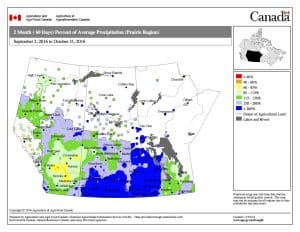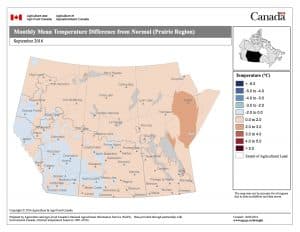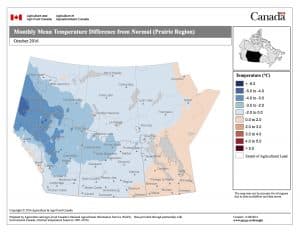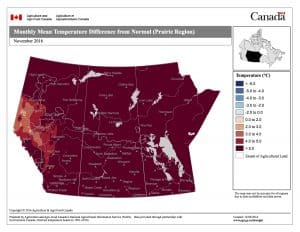Growers were optimistic through most of 2016, due in large part to an early start and decent moisture during crop establishment. Crops were thick and lush through June and July and record tonnage and Prairie-average yields seemed possible. But high yield potential meant high sclerotinia stem rot risk and by harvest, our number one disease was showing its damage. Fields that were not sprayed (some because wet conditions wouldn’t allow for it) had high levels of disease and yield loss. As if that weren’t enough, continuous rain, early snow and cool conditions through part of September and most of October held up harvest. Crop was ready, but fields were too wet. A summer-like November salvaged the year.
As one CCC agronomy specialist said in comparing 2015 to 2016: A great crop you can’t harvest (2016) is worse than a miserable-looking crop you can (2015) — especially when that miserable crop yielded better than anyone expected.
Canola acres seeded in 2016: 20.0 million
Harvested acres: 19.2 million
Avg yield: 42.3 bu./ac. (a record)
Production: 18.4 million tonnes
Source: Statistics Canada November 2016 estimates




prairie-growing-degree-days-base-0-2016
prairie-precip_percent-of-normal-_2016-growing-season
prairie-temp_no-of-days-above-30-april-1-july-18-2016
april2016_temperature_percent_of_normal
Find these Agriculture and Agri-Food Canada agroclimate maps at www.agr.gc.ca.
Highlights by pillar
Stand establishment
Many growers across the Prairies were looking at an early start, with spring coming two or three weeks early, especially in the Western Prairies. Seeding therefore wrapped up early, for the most part, however some growers in more southern latitudes seeded into dry conditions and then waited for rain. Some seed that hit moisture emerged early. Some didn’t emerge until the rain, that was fairly general across most of the Prairies by the third week of May. The result was patchy emergence in some fields. Spring frosts resulted in some reseeding, but nothing like 2015 where a million or more canola acres were reseeded.
Fertility management
Phosphorus rates, in general, continue to lag crop removal rates. Deficiency symptoms have been observed for all macronutrients. Soil nitrogen reserves may be lower this fall after high biomass crops and high mineralization rates due to higher moisture. In some fields, this may have translated into higher yields than fertilizer rates would suggest, which means N rates may need to be higher next year to compensate. However, some growers who pushed N rates for higher yield were disappointed because a lot of that extra N went into biomass, but this didn’t always transfer to higher yields. If harvested seed yield was less than plant biomass would suggest, then much of that N taken up by plants will still be on the field and will be released as residue decomposes.
The UCC trials conducted this year focused on adding more N to see if additional yield and profit could be obtained. In a wet year like 2016, about half the trials that were established did see an increase in yield and profit by increasing N by 25%. This indicates that producers may be underfertilizing for their yield potential in many areas.
The flowering period persisted for much longer than normal – which may have been due the climatic conditions and due to some fertility challenges.
Integrated pest management
Sclerotinia stem rot was the big yield-robbing pest for 2016. With high moisture and high biomass through the flowering period, the situation was ripe for sclerotinia. The disease delivered, dropping yield for many unsprayed and sometimes also sprayed acres. In fields that flowered for long periods, a split application of fungicide may have paid off in 2016. As for insects, flea beetles were normal, cabbage seedpod weevil were also normal to above average, and late-season threats lygus, diamondback moth and bertha armyworm were almost nonexistent. The few bertha “hotspots” that did occur were small.
Cutworm issues were patchy, as usual, across the Prairies. Extreme pressure in the Swan River Valley of Manitoba made uneven stands even worse.
Harvest management
Harvest stands out as the big challenge for 2016. Combining started strong in late August but just as the bulk of canola acres were ready to swath or combine or straight combine, the Prairies were hit by weeks of rain and snow and cool temperatures. Harvest was at a virtual standstill for a few weeks, then restarted slowly until year-saving warm and dry conditions in November. Add in that straight combining acres perhaps doubled in 2016 over 2015 (we don’t have numbers), and it meant for a stressful two months across the Prairies. About 10% of canola acres in Alberta are still not harvested. Pushing to harvest when possible meant a lot of tough and damp canola went in the bin, increasing storage risk and costs for drying.
Lodged canola made for some extremely difficult swathing jobs. Lodging was the result of myriad causes stacking up: Variety, nitrogen rates, non-uniform or thin plant stands, hail, wind, heavy rain, sclerotinia, etc.
